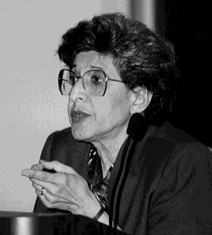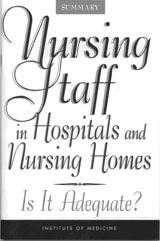Is Nursing Staff in Hospitals and Nursing Homes Adequate?
June 22, 1997

Dr. Gooloo S. Wunderlich, a researcher with more than 40 years' experience at the program and policy levels in health and population statistics, delivered the 1996 Hugh P. Davis Lecture at the
School of Nursing.
The 1996 Hugh P. Davis Alumnae Lecture at the Nell Hodgson Woodruff School of
Nursing was presented on March 29, 1996 by Dr. Gooloo S. Wunderlich, Senior Program Officer
at the Institute of Medicine (IOM), National Academy of Sciences. The title, "Overview and
Major Findings of the Report of the Committee on Nursing Staff in Hospitals and Nursing
Homes," was based on a recent report developed from a study requested by the National Institute
of Nursing Research (NINR) to the IOM. In response, an interdisciplinary committee on the
Adequacy of Nursing Staffing in Hospitals and Nursing Homes was established in 1994 to
conduct a national study that was directed by Dr. Wunderlich. The Emory Nursing Dean, Dr.
Dyanne Affonso, was one of the nursing representatives on the committee.
According to Dr. Wunderlich, the rapid growth of managed care organizations combined
with continuing demands to deliver cost-effective care under pressures of cost containment and
increasing competition, has led to major changes in the structure and delivery of health care in
this country. The shift to outpatient, ambulatory, and community-based care in general, and
managed care in particular has resulted in a reduced volume of inpatient care. As a consequence,
hospitals are restructuring, redesigning staffing patterns, moving towards interdisciplinary teams
of caregivers, and downsizing staff. Nurses, their professional organizations, and their unions
have expressed concerns that hospitals are implementing delivery systems involving major
downward staff substitutions, thereby endangering patient care quality and causing higher
incidence of work-related injuries and stress. The IOM committee, however, was unable to find
evidence of decline of quality of hospital care because of changes in staffing patterns, or of
reductions of registered nurse (RN) staffing levels in hospitals on a national level, suggesting that
in the aggregate these losses appear to have been more than offset by hires. Dr. Wunderlich
emphasized the need for valid and timely information on employment patterns of nursing staff in
the health care system and several other issues the committee was charged to examine. She noted
that the redesign of nursing services in hospitals is leading to changes in the role and
responsibilities of nursing personnel and increasing the emphasis on interdisciplinary teams.
While the RN remains in a central position for coordinating care in the hospital, sometimes as
case manager, nurse assistants are being assigned, under the direction of the RN, increasing
responsibility for direct care activities, without benefit of uniform national requirements for
training and certification. As a result, RNs are increasingly being called upon to fill roles that
require increased professional judgment, supervision and direction of work of others, requiring
increasing levels of supervisory and management skills.

The study determined that nursing staffs are being cut as a result of the rapid growth of managed care organizations and the resultant pressure to deliver cost-effective care amid soaring competition for health care dollars.
General recommendations from the IOM committee that were described by Dr.
Wunderlich included the need by hospitals to expand the use of RNs with advanced practice
preparation, and the skills to provide the clinical leadership and cost-effective patient care,
particularly for patients with complex management problems. Also, hospitals should have
documented evidence that nurse assistants and other ancillary nursing personnel in patient care
positions are tested and certified for this competence by an appropriate entity. The committee
also cautioned that if hospitals do not take these steps now, ultimately, regulation may become
necessary.
In addition, the committee was emphatic about the significant contribution of professional
nursing care in nursing homes. The IOM committee found problematic the lack of any RN
presence in many facilities in the evening and on night shifts. According to Dr. Wunderlich, "The
knowledge and judgment of an RN is critical in a crisis or a regression of a condition; early
detection and intervention often forestall the use of expensive measures such as hospitalizations
and admissions to emergency rooms. In addition to the beneficial effect on patient outcomes,
reduced rehospitalizations and visits to emergency rooms were also found to lead to cost savings
in the long run."
Dr. Wunderlich had insightful final remarks regarding the dynamics surrounding the
nursing workforce within the context of rapidly changing demands in the U.S.: "The nursing
workforce issues should be studied not in isolation but as an integral part of the overall health
workforce. If we do not take the initiative to collect and analyze appropriate data and undertake
rigorous research, a few years from now there will be a call for another study of nurses, and we
will continue to be plagued with similar issues and no adequate answers."
Reprinted from Emory Nursing, Spring 1997
For more general information on The Robert W. Woodruff Health
Sciences Center, call Health Sciences News and Information at
404-727-5686, or send e-mail to
hsnews@emory.edu.
DIRECTORY
| SEARCH |
WEB INFO |
INDEX |
WHAT'S NEW
EMORY |
WHSC |
NEWS AND INFORMATION |
PUBLICATIONS
TABLE OF CONTENTS
Copyright ©Emory University, 1997. All Rights Reserved.
Send comments to
whscweb@emory.edu


